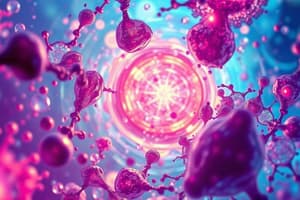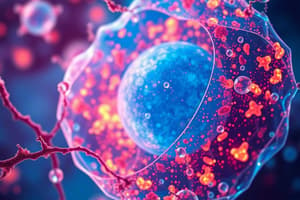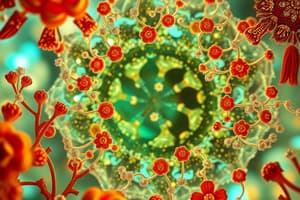Podcast
Questions and Answers
What process do cells undergo to reproduce?
What process do cells undergo to reproduce?
- Fission
- Division (correct)
- Meiosis
- Budding
Which molecule stores energy in cells derived from glucose?
Which molecule stores energy in cells derived from glucose?
- NADPH
- DNA
- RNA
- ATP (correct)
What factor is essential for increasing the rate of chemical reactions in cells?
What factor is essential for increasing the rate of chemical reactions in cells?
- Enzymes (correct)
- Proteins
- Buffer solutions
- Acids
How do cells primarily acquire energy?
How do cells primarily acquire energy?
What is the total of all chemical reactions that take place in a cell called?
What is the total of all chemical reactions that take place in a cell called?
Which type of proteins change shape to initiate mechanical activities within cells?
Which type of proteins change shape to initiate mechanical activities within cells?
What ability do cells have in response to stimuli?
What ability do cells have in response to stimuli?
What kind of information do genes store?
What kind of information do genes store?
What is one way cells may respond to stimuli?
What is one way cells may respond to stimuli?
What role do feedback circuits play in cellular function?
What role do feedback circuits play in cellular function?
Which statement best describes the components involved in cellular metabolism?
Which statement best describes the components involved in cellular metabolism?
What do all living organisms share according to modern biological tenets?
What do all living organisms share according to modern biological tenets?
Which characteristic distinguishes prokaryotic cells from eukaryotic cells?
Which characteristic distinguishes prokaryotic cells from eukaryotic cells?
Which feature is common to both prokaryotic and eukaryotic cells?
Which feature is common to both prokaryotic and eukaryotic cells?
What is the last universal common ancestor often referred to as?
What is the last universal common ancestor often referred to as?
What aspect of cellular activity requires constant regulation?
What aspect of cellular activity requires constant regulation?
What is the primary location of genetic material in eukaryotic cells?
What is the primary location of genetic material in eukaryotic cells?
Which of the following statements accurately describes eukaryotic cells compared to prokaryotic cells?
Which of the following statements accurately describes eukaryotic cells compared to prokaryotic cells?
How do prokaryotic cells primarily reproduce?
How do prokaryotic cells primarily reproduce?
What type of organelles are typically absent near the cell membrane in a eukaryotic cell's cytoplasm?
What type of organelles are typically absent near the cell membrane in a eukaryotic cell's cytoplasm?
What is a key difference regarding ribosomes between prokaryotic and eukaryotic cells?
What is a key difference regarding ribosomes between prokaryotic and eukaryotic cells?
Which structure is primarily responsible for locomotion in prokaryotic cells?
Which structure is primarily responsible for locomotion in prokaryotic cells?
Approximately how long ago did complex multicellular animals appear in the fossil record?
Approximately how long ago did complex multicellular animals appear in the fossil record?
What primarily limits cell size?
What primarily limits cell size?
What distinguishes the cytoplasm of eukaryotic cells from that of prokaryotic cells?
What distinguishes the cytoplasm of eukaryotic cells from that of prokaryotic cells?
What is one goal of Synthetic Biology?
What is one goal of Synthetic Biology?
Which of the following describes a virion?
Which of the following describes a virion?
What determines the viral specificity for a certain host?
What determines the viral specificity for a certain host?
Which type of viral infection leads to the lysis of the host cell?
Which type of viral infection leads to the lysis of the host cell?
What do viroids consist of?
What do viroids consist of?
What is the purpose of viral capsids being made from a limited number of proteins?
What is the purpose of viral capsids being made from a limited number of proteins?
What characterizes the integration type of viral infection?
What characterizes the integration type of viral infection?
What fundamental principle is cell biology based on?
What fundamental principle is cell biology based on?
Who first coined the term 'cells' while observing cork?
Who first coined the term 'cells' while observing cork?
According to cell theory, where do cells arise from?
According to cell theory, where do cells arise from?
What genetic material is crucial for building an organism and is stored within the cell nucleus?
What genetic material is crucial for building an organism and is stored within the cell nucleus?
Which cells are known for their ability to grow and reproduce in culture over extended periods?
Which cells are known for their ability to grow and reproduce in culture over extended periods?
What is the primary genetic programming material that cells utilize?
What is the primary genetic programming material that cells utilize?
What similarity is observed among cells from different species?
What similarity is observed among cells from different species?
What does the term 'animalcules' refer to in cell biology?
What does the term 'animalcules' refer to in cell biology?
Flashcards are hidden until you start studying
Study Notes
Discovery of Cells
- Intensive study of cells involves creative tools and techniques.
- Cell biology is reductionist, focusing on how studying parts reveals the whole.
Microscopy
- Microscopes enabled visualization of cells.
- Robert Hooke named the pores he saw in cork "cells," likening them to monk cells.
- Antonie van Leeuwenhoek observed "animalcules" in pond water and bacteria from peppercorn.
Cell Theory
- Formulated in the mid-1800s by Matthias Schleiden, Theodor Schwann, and Rudolf Virchow.
- States: All living organisms are made of cells; the cell is the basic unit of life; cells arise from pre-existing cells.
- Additional tenet: Cells contain DNA, which is passed to subsequent generations.
Basic Properties of Cells
- Life defines the fundamental property of cells, which can grow and reproduce.
- HeLa cells are immortal tumor cells from Henrietta Lacks, used extensively in research.
- Cellular processes are highly regulated, with similarities across species in structure and metabolism.
Genetic Programming
- Genes, encoded in DNA within the nucleus, direct cellular structure and function.
- Can exist as haploid (one set) or diploid (two sets) genetic material.
Cell Reproduction
- Involves division, distributing contents from a mother cell to two daughter cells.
Energy Acquisition
- Photosynthesis is essential for energy; animal cells primarily utilize glucose.
- Energy is stored in ATP, allowing for quick energy release.
Chemical Reactions
- Cells function as miniature chemical plants, with enzymes facilitating metabolic processes.
- Metabolism encompasses all cellular chemical reactions.
Mechanical Activities
- Cells engage in transport, assembly/disassembly of structures, and movement.
- Many mechanical functions are driven by changes in the shape of motor proteins.
Response to Stimuli
- Cells respond to environmental changes through receptors that interact with hormones and other substances.
- Responses may include metabolic alterations, movement, or programmed cell death.
Self-Regulation
- Cells maintain stability despite fluctuations through feedback mechanisms.
- Coordination of nucleic acids (for design) and proteins (for execution) is crucial.
Evolution of Cells
- Origin remains unclear, but evolution studied through current organisms.
- All living cells share features like a common genetic code and ribosomes.
- All life forms are believed to have evolved from a single ancestral cell, known as LUCA.
Classes of Cells
- Two primary classes: Prokaryotic (bacteria) and Eukaryotic (plants, animals, fungi, protists).
- Differences include size, organelles, genetic material structure, and complexity.
Distinguishing Characteristics
- Prokaryotic cells lack membrane-bound organelles and have simpler structures.
- Eukaryotic cells have a nucleus and more complex organelles.
Eukaryotic DNA
- Eukaryotes possess larger amounts of DNA compared to prokaryotes.
- Complex multicellular organisms appeared suddenly in the fossil record about 600 million years ago.
Eukaryotic vs. Prokaryotic Functions
- Eukaryotic cytoplasm contains organelles and denser macromolecular complexes, including ribosomes.
- Eukaryotes reproduce through mitosis, while prokaryotes undergo simple fission.
Eukaryotic Cell Crowding
- Eukaryotic cell cytoplasm is densely packed, affecting cell functionality.
- Size limitations based on supporting cytoplasm volume and diffusion efficiency.
Synthetic Biology
- Aims to create living cells in labs, with goals of developing novel organisms for medicine and industry.
- Successful genome replacement in bacteria suggests promising applications.
Viruses and Viroids
- Viruses act as intracellular obligate parasites, requiring host cells for reproduction.
- A virion consists of genetic material and protein subunits, with some having a lipid envelope.
Virus Types and Mechanisms
- Bacteriophages exhibit complex infection cycles, showcasing medicinal potential.
- Viroids, composed of naked RNA, disrupt host gene expression.
Capsid Structure and Function
- Viral capsids consist of a few protein subunits to optimize genome size and specificity.
- Virus specificity is determined by surface proteins that bind to host cell receptors.
Viral Infection Types
- Lytic infections lead to the host cell's lysis and release of new virions.
- Integration infections see the viral DNA becoming part of the host’s chromosomes.
Studying That Suits You
Use AI to generate personalized quizzes and flashcards to suit your learning preferences.




